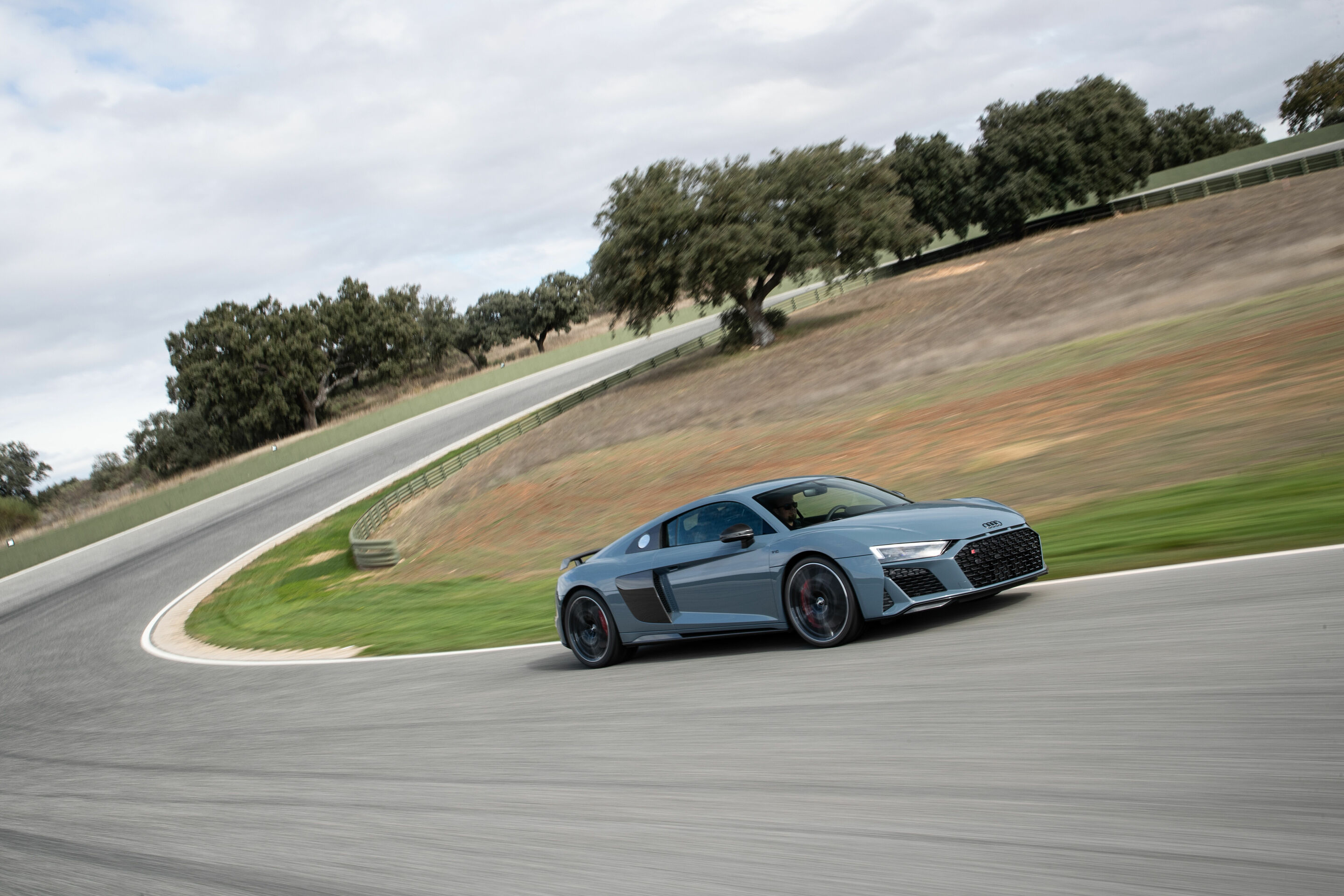Suspension
Back to overviewThe suspension of the new Audi R8 also makes use of motorsport technologies. Aluminum double wishbones guide all four wheels. The set-up varies depending on the engine variant. The springs and dampers are more taut in the top-of-the-line version. The regulated damping system Audi magnetic ride is available upon request for both the basic and performance variants of the R8. The system adapts the mode of operation of the shock absorbers to the road profile and the driver’s style continuously and at millisecond intervals for each individual wheel. A synthetic oil in the pistons of the shock absorbers has very small magnetic particles embedded in it. When a voltage is applied to a coil, a magnetic field is generated in which the particles align themselves transverse to the direction of flow. They thereby restrict the flow of oil through the piston channels.
In connection with the Audi magnetic ride and the performance sport suspension, there is a new option available that comes straight from motor racing: A stabilizer at the front axle that consists of coiled layers of carbon fiber-reinforced polymer (CFRP). These layers form its pipe, and the sides consist of red anodized aluminum. This innovative material concept reduces the weight at the front axle by roughly two kilograms (4.4 lb), which corresponds to 35 percent.
Electromechanical rack-and-pinion power steering is standard equipment in the new Audi R8. Upon request, Audi can install dynamic steering with an integrated superposition gear. It changes the gear ratio between 10.5:1 and 15.8:1 depending on the driving speed. The steering is very direct during maneuvering, while it is calm and smooth on the freeway. In the Performance programs, which are standard in the R8 V10 performance quattro, the ratio is fixed to approximately 14.0:1. Thanks to the newly adjusted steering assistance, the driver experiences even more precise response characteristics and a very exact response from the road across the entire speed range.
The Audi R8 is equipped with the dynamic handling system Audi drive select as standard. The system accesses important technical elements such as the quattro drive, accelerator, steering and S tronic. The Dynamic mode is programmed to provide maximum driving pleasure – it assists with spontaneous turning and offers handling with slight oversteer. In the auto mode, on the other hand, traction has priority – this translates into high speed and fast lap times on the race track.
The Audi R8 V10 performance quattro offers even more precise handling that is adapted to the respective route conditions. Here, Audi drive select has three additional programs – dry, wet, and snow – that the driver controls via a satellite button that includes a setting dial on the steering wheel. They too are configured for maximum dynamic performance, and they take the friction coefficient of the road surface into consideration. Audi drive select also accesses the mode of operation of the ESC here. When the road surface is wet or covered in snow, for example, the control thresholds are adapted accordingly. In “wet” mode, for example, traction control starts regulating earlier and more gently. The goal is to achieve maximum traction. Independently of this, the driver can set the Electronic Stabilization Control ESC to ESC Sport or deactivate it completely. In performance mode, the top-of-the-line model switches to ESC Performance Mode automatically. The refined ESC reduces the braking distance to 1.5 meters (4.9 ft) when decelerating from 100 km/h (62.1 mph) to a standstill. The braking distance from 200 km/h (124.3 mph) is even up to five meters (16.4 ft) shorter, depending on the exterior conditions in each case.
High grip level: wheels and tires
The standard version of the new Audi R8 comes off the production line with 19-inch wheels with 245/35 tires mounted at the front and 295/35 tires at the rear. Newly designed milled 20-inch wheels in five-V dynamic design with three different surfaces are available as an alternative. They are fitted with tires with the dimensions 245/30 and 305/30, respectively. New and longer lasting 20-inch summer and sport tires are also available for a particularly dynamic driving style of the Audi R8 and further increased performance.
The standard-fit steel disks of the new Audi R8 V10 quattro are internally ventilated and pierced. For reasons relating to lightweight design, they have wave-shaped contours, also known as wave design. Operating at the front wheels are eight-piston fixed calipers and disks 365 mm (14.4 in) in diameter; at the rear wheels, four-piston calipers and disks 356 mm (14.0 in) in diameter are used. Audi can replace the black brake calipers with red ones upon request.
The Audi R8 V10 performance quattro decelerates with carbon fiber-reinforced ceramic disks that are extremely heat-resistant and durable. Their cooling ducts ensure that heat is dissipated quickly and the friction rings are screwed in with forged aluminum bowls. They are 380 mm (15.0 in) in diameter at the front (with six-piston fixed calipers) and 356 mm (14.0 in) at the rear (with four-piston calipers). The ceramic disks are eleven kilograms (24.3 lb) lighter in weight than their steel counterparts. The brake calipers come in anthracite gray as standard and are available in red as an option.
All terms marked in the text are explained in detail in the technology lexicon at www.audi-mediacenter.com/en/technology-lexicon.
The equipment, data and prices specified in this document refer to the model range offered in Germany. Subject to change without notice; errors and omissions excepted.
